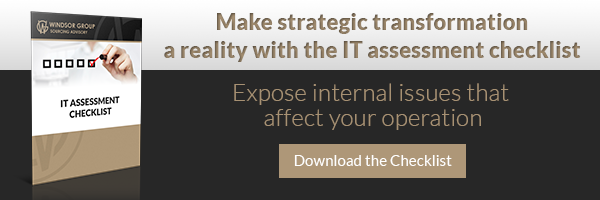
Every executive knows that you can’t make good decisions about what to change without knowing why you want change in the first place. You have long-term goals in mind, of course. But change is driven by what you don’t have – but need – to propel your company toward those goals. You need to establish a baseline, and an IT infrastructure assessment enables you to do that.
Large enterprises are transforming the way they view and use IT functions, often choosing outsourcing to capture the latest technology innovations, streamline and better integrate operations, save money and vastly increase flexibility. If you’re on the brink of transformation, an IT infrastructure assessment becomes even more crucial, because the baseline you create to evaluate potentially dramatic change is actually just the first step in building a high-level business case.
Undertaking your IT infrastructure assessment in a systematic fashion allows you to build a business case that’s both comprehensive and accurate. Think of it as a three-step process.
You can establish a “current IT services” baseline.
Identify platforms, applications and services you now provide to each of your business units, enterprise-wide. Even though you already know in general how your IT functions are organized, charting everything in this way will give you a detailed understanding of your current strengths, weak areas and gaps in service levels or quality. Even your IT staff might be surprised by what you see.
Identify costs associated with each area, to further flesh out your baseline. Include every cost – any ongoing expenses that might be allocated to some other budget line, and indirect costs such as amortization and depreciation. Leaving anything out only skews your “total” cost of ownership. It might look lower, but you need to know your true TCO to make cost-effective changes.
Remember that TCO is a multi-year proposition, not a snapshot. If you’re considering IT outsourcing you’ll want to project that number over the same length of time you might expect a provider contract to last.
Complete this initial baseline by documenting any assumptions you’re using regarding current and future needs. This is where you tie your IT infrastructure assessment to your long-term goals.
You can establish an “areas of opportunity” baseline.
Your strengths, weaknesses and missing capabilities all represent opportunities. You can address them by improving in-house infrastructure and processes, or you can use various outsourcing options to offload this work and re-prioritize in-house activities.
Using your IT infrastructure assessment to delineate exactly what you need enables you to investigate alternatives most strategically. The third-party-provider marketplace offers a surprising array of choices to help you make very specific IT improvements or make sweeping changes in what you do and how you do it. There are numerous pricing models, too.
Your opportunities baseline should include internal drivers as well as function-and-cost data. Think about cultural or customer-driven requirements that will affect, or will be affected by, your transformation decisions.
You can establish the ultimate baseline, your high-level business case.
Taken together, your current-services and opportunities baselines provide the foundation to create the ultimate cost-benefit analysis – your business case. Your IT infrastructure assessment has given you thorough, accurate data about internal and external options, the costs, risks and benefits.
Even if your business case indicates outsourcing isn’t your best option right now, you’ve learned more about your organization – in far greater detail and in a very organized approach – than you knew before. At the very least, you’ve looked at what you already knew from a different strategic perspective. Coupled with what you’ve learned about marketplace options, that can lead to new internal thinking and improvements.
The baselines you develop via IT infrastructure assessment enable you plan more strategically for the future, whatever that brings.


